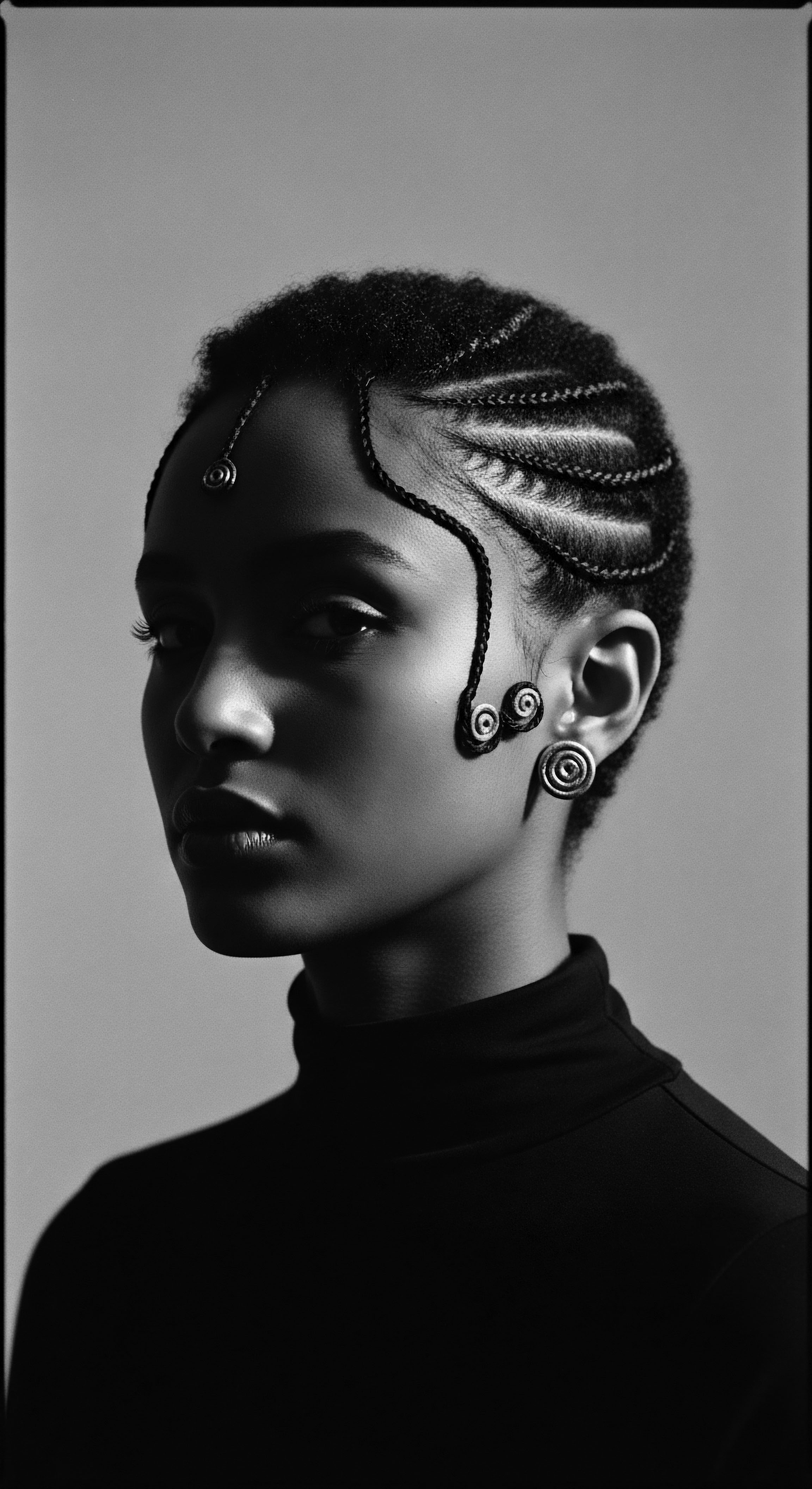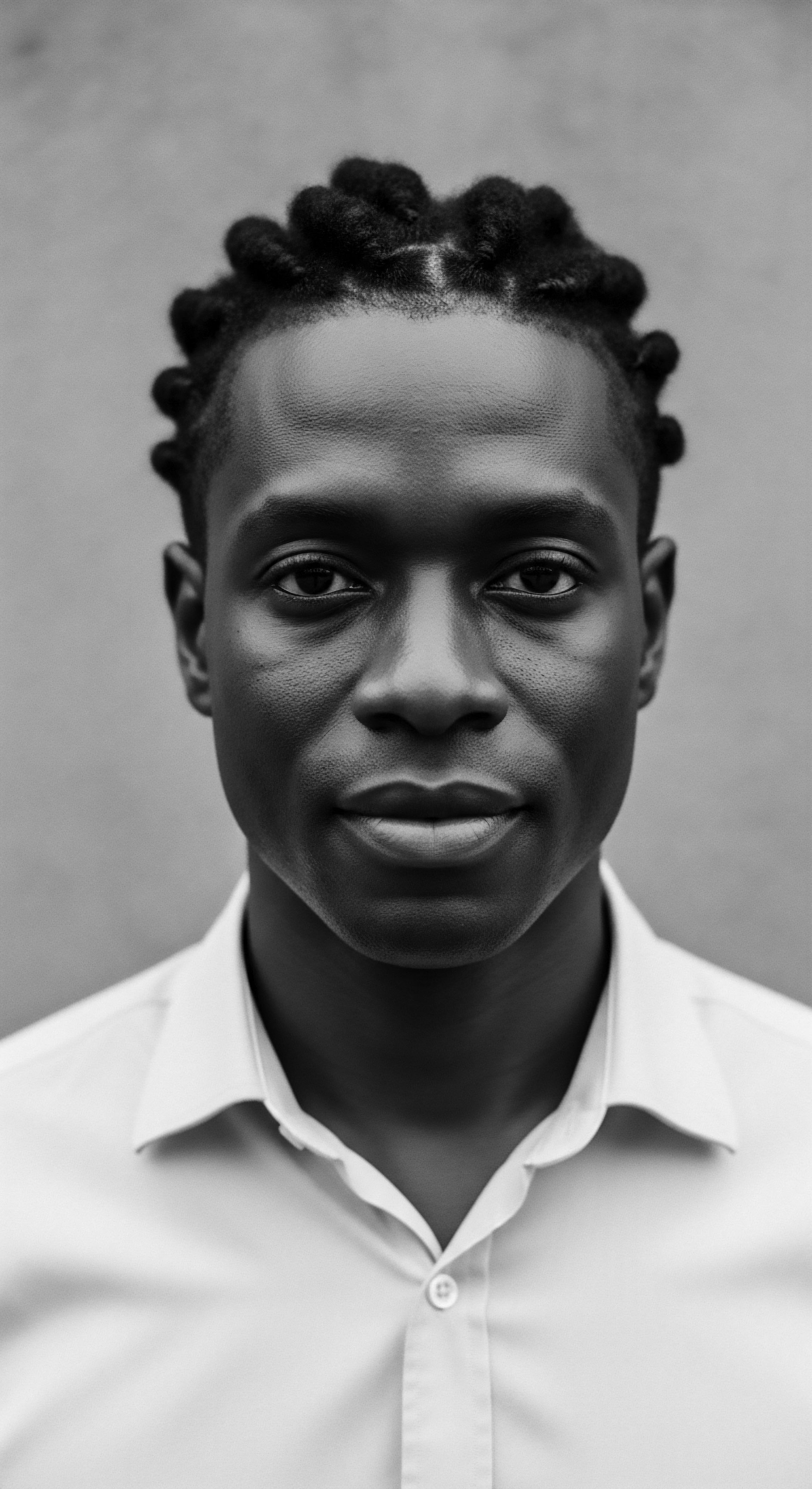The concept of Natural Colorants, particularly within the narrative of textured hair, resonates as an elemental whisper from the earth, a testament to ancestral ingenuity, and a vibrant marker of identity. Roothea understands these hues not merely as agents of change for a strand’s visual spectrum, but as storytellers of lineage, tradition, and profound connection to the sources that sustain us. The definition of Natural Colorants extends beyond mere chemical composition, reaching into the very significance of cultural practices and the deep sense of self that adorns each curl, coil, and wave.

Fundamentals
Natural Colorants are substances derived directly from botanical, mineral, or sometimes animal sources, imparting pigments to materials without the need for synthetic chemical alterations. Their origin traces back to the earliest human civilizations, long before the advent of industrial chemistry. These organic compounds, known as chromophores, lend their unique spectrum to a variety of substrates, including textiles, skin, and, profoundly, hair. The process involves extracting these color-bearing molecules, often through simple methods like heating and steeping, and then applying them.
The hues obtained are often earthy, subtle, and possess a depth that reflects their origins. This stands in beautiful contrast to the often uniform and intensely vivid results of synthetic dyes.
For individuals with textured hair, especially those with Black or mixed heritage, the understanding of Natural Colorants holds a foundational meaning. Long before commercial products became available, communities across Africa and the diaspora looked to their immediate environments to care for and adorn their hair. The very land provided both sustenance and the tools for self-expression, a connection that speaks to an intuitive, generational wisdom. This knowledge, passed through oral traditions and communal rituals, laid the groundwork for sophisticated hair care practices that recognized the inherent properties of various plants and earth elements.

Elemental Expressions in Hair Care
The journey of Natural Colorants begins with their discovery in nature’s vast laboratory. Each plant, soil, or creature holds a unique palette waiting to be unveiled. The application of these elements to textured hair was not just about superficial change; it often served practical purposes, offering protection, conditioning, and even medicinal benefits. This historical context provides an essential lens through which to comprehend the significance of Natural Colorants for hair.
- Ochre ❉ Earth pigments, often rich in iron oxides, provided shades of red, brown, and yellow. These were widely used across African communities for hair and body adornment, offering both color and sun protection. For instance, the Himba people of Namibia are renowned for their use of otjize, a paste of ochre, butterfat, and aromatic resin, applied to hair and skin, signifying age, marital status, and a profound connection to their ancestral lands.
- Henna ❉ Derived from the dried leaves of the Lawsonia inermis plant, henna yields reddish-brown hues. Its use in hair coloring and body art spans thousands of years, with significant historical presence in North, East, and West Africa. Henna was not just a cosmetic tool but also a sacred element in rituals, symbolizing protection and celebration.
- Indigo ❉ Sourced from plants such as Indigofera tinctoria, this yielded deep blue tones. Though less common for hair alone, indigo was often combined with henna to achieve darker, richer shades, a practice seen in various traditional dyeing crafts.
The earliest uses of these plant and earth-based materials were born of necessity and deep observation. Understanding how different elements could impart specific colors, or even improve the health and manageability of hair, was a testament to the intimate relationship between ancestral communities and their environment. This fundamental recognition of nature’s bounty as a source of aesthetic expression and practical care forms the bedrock of our understanding of Natural Colorants.
The initial draw of Natural Colorants for hair arose from an intuitive understanding of nature’s capacity to both beautify and nourish, establishing an enduring legacy of ancestral hair care.
The application of these substances was not merely about aesthetic alteration; it was often integrated into holistic hair care routines. Beyond color, elements like ochre provided a protective layer against harsh environmental conditions, while plant extracts could offer conditioning properties. This dual function, providing both visual appeal and practical benefit, highlights the comprehensive approach to hair wellness in these heritage traditions. For a strand of hair, it meant receiving care that was deeply attuned to its needs, a practice that resonates with modern desires for wholesome, gentle treatment.

Intermediate
Moving beyond the foundational definition, the intermediate understanding of Natural Colorants for textured hair delves into the underlying principles of their interaction with hair fibers and the cultural contexts that shaped their usage. The molecules responsible for color, known as chromophores, interact with the protein structures of hair, primarily keratin, through a process of absorption or coating. Unlike synthetic dyes that penetrate deep into the hair shaft through chemical reactions, many natural colorants work by depositing pigments on the outer cuticle layers or subtly staining the cortex. This mechanism often results in more translucent, multi-tonal effects, which can vary with the hair’s inherent texture, porosity, and baseline color.
The nuanced meaning of Natural Colorants within Black and mixed-race hair experiences is intrinsically linked to identity and communal ritual. In pre-colonial African societies, hair was a powerful communication tool, conveying a person’s age, marital status, social standing, tribal affiliation, and even spiritual beliefs. The colors chosen, often derived from local flora and minerals, were integral to these complex visual languages. Hairdressing was frequently a communal activity, fostering social bonds and transmitting cultural knowledge across generations.

Cultural Significance and Application Techniques
The historical significance of Natural Colorants is particularly profound when considering the ways they were applied and the meanings they conveyed within various African and diasporic communities. The preparation of these colorants was often a labor-intensive process, involving careful selection, grinding, and mixing of ingredients, reflecting the reverence for the natural world and the artistry involved in hair care.
Consider the Himba women of Namibia, whose distinctive red hair is a testament to their deep cultural practices. The otjize paste, a blend of ground ochre, butterfat, and aromatic Commiphora resin, is not just a cosmetic application. It serves as a daily ritual that protects hair and skin from the desert environment, while also symbolizing blood, earth, and the essence of life within their worldview. This ongoing practice illustrates how a Natural Colorant is interwoven with survival, spirituality, and identity, moving beyond a simple definition of color.
- Protective Layers ❉ Many traditional colorants, particularly those with a clay or mineral base like ochre, formed a protective barrier on the hair shaft, shielding it from sun, dust, and insects. This functional aspect speaks to a holistic approach to hair care, where adornment and preservation converged.
- Conditioning Properties ❉ Plant-based colorants often contained compounds with inherent conditioning benefits. For instance, henna is known to nourish the scalp, strengthen strands, and add a natural sheen to hair. The process of applying such colorants often involved oils and other nourishing ingredients, further contributing to hair health.
- Ritualistic Meaning ❉ The application of colorants was frequently accompanied by ceremonies or specific social contexts, transforming the act into a meaningful ritual. In West Africa, indigo was sometimes part of wedding preparations, sent by the groom to the bride along with other precious items, signifying blessings and well-being.
The selection and application of Natural Colorants reflected an intimate understanding of the natural world, a form of ethnobotany that predates formal scientific classification. This nuanced appreciation of their properties, both aesthetic and practical, speaks to the profound wisdom embedded in traditional hair care routines. The choice of color was not arbitrary; it was a deliberate expression of identity, status, and connection to a broader cultural narrative. This level of intentionality elevates Natural Colorants beyond mere pigments, repositioning them as integral components of a living heritage.
| Aspect Source & Acquisition |
| Traditional/Ancestral Practice Harvested from local plants, minerals, insects; often seasonal and location-dependent. |
| Modern/Contemporary View Commercially sourced, standardized extracts; emphasis on ethical sourcing and organic certification. |
| Aspect Application Method |
| Traditional/Ancestral Practice Labor-intensive grinding, mixing; communal rituals; direct application often with hands or simple tools. |
| Modern/Contemporary View Powdered mixes, pre-formulated pastes; at-home kits or salon application; convenience-focused. |
| Aspect Purpose Beyond Color |
| Traditional/Ancestral Practice Protection from elements, spiritual symbolism, social communication, scalp health. |
| Modern/Contemporary View "Clean beauty" appeal, perceived health benefits, personal aesthetic expression, avoiding synthetic chemicals. |
| Aspect The continuity of natural colorants across generations highlights a deep human desire for connection with the earth's offerings, regardless of evolving application methods. |

Academic
From an academic perspective, Natural Colorants represent a compelling interdisciplinary field, drawing from organic chemistry, ethnobotany, cultural anthropology, and cosmetic science. They are defined as complex organic compounds, primarily secondary metabolites, extracted from living organisms or geological formations, that impart color through their inherent chromophoric structures. These molecules, including anthocyanins, flavonoids, tannins, carotenoids, and indigoids, interact with hair fibers via various mechanisms ❉ adsorption, hydrogen bonding, ionic bonding, and metallic chelation (when mordants are employed). The ultimate hue, vibrancy, and longevity of the color are functions of the specific chromophore, the hair’s keratinous substrate, pH conditions, and the presence of auxochromes or mordanting agents that enhance dye uptake and lightfastness.
The meaning of Natural Colorants, particularly for textured hair within Black and mixed-race communities, extends into the very architecture of identity and resistance. Historical data reveals a deeply intertwined relationship between hair, its adornment, and socio-political agency. In pre-colonial African societies, intricate hairstyles and their embellishments, which often included natural pigments, were not merely decorative. They served as a sophisticated form of non-verbal communication, encoding information about a person’s lineage, age, social standing, marital status, and even spiritual allegiance.
An ethnographic study by Chéri R. Matjila, detailed in her 2020 submission, “The ‘Business’ of hair ❉ the meaning of hair for Southern African Black women,” provides a compelling case study on the enduring meaning of natural hair, often inclusive of natural coloring practices, in the face of Eurocentric beauty standards. Matjila’s research, conducted among Black women in contemporary Namibia and South Africa, reveals that the relationship these women have with natural hair is often strongly related to processes of identity formation. Her findings indicate that for some participants, embracing natural hair, which can include the application of traditional colorants like ochre (as seen in the Himba tradition), reflects a deeper spiritual and metaphysical connection with their hair.
This connection is not merely an aesthetic choice; it becomes an important form of social activism, challenging persistent stereotypes and reclaiming a cultural heritage that was historically suppressed. The study found that such choices move beyond a simple binary of ‘natural’ or ‘un-natural’ hair, emphasizing the complex, multi-layered interpretations and agency involved.
The academic lens on Natural Colorants sharpens our focus on the profound intergenerational knowledge that underpinned their use. This wisdom, often dismissed by colonial narratives, involved a deep understanding of botany, chemistry, and environmental rhythms. Traditional dye masters knew instinctively that factors such as the harvest time of a plant, the soil composition, and even the lunar cycle could influence the vibrancy and durability of the pigments extracted. This empirical knowledge, accumulated over centuries, enabled communities to reliably produce desired hues and ensure their adherence to the hair fiber, even without the aid of modern scientific instruments.
Natural Colorants embody a living archive of scientific ingenuity and cultural resilience, their very hues narrating histories of identity and sustained connection to ancestral wisdom.
The examination of this historical chemical knowledge offers a rich repository for contemporary scientific investigation and the revival of sustainable practices. For instance, modern analytical techniques, like liquid chromatography/mass spectrometry, are now being employed to study the chemical underpinnings of traditional Indigenous dyes, seeking to understand how pigments change with seasons or plant variations. This intersection of traditional ecological knowledge with modern scientific inquiry not only validates ancestral practices but also offers avenues for novel, environmentally conscious solutions in cosmetic science.

Deepening the Understanding of Ancestral Practices
The long-term consequences of neglecting ancestral hair care wisdom, particularly in the context of Natural Colorants, become apparent when examining the historical oppression of textured hair. During the transatlantic slave trade, the deliberate shaving of African captives’ heads was a brutal act of dehumanization, a systematic effort to strip individuals of their identity and cultural markers. This profound disruption severed generations from their traditional hair care practices, including the use of Natural Colorants that symbolized belonging and status. The imposition of Eurocentric beauty standards subsequently led to the widespread use of harsh chemical straighteners, often with detrimental health consequences, as Black women sought to conform to societal pressures.
The contemporary movement to embrace natural hair, and by extension, the use of Natural Colorants, represents a powerful act of reclamation. It is a return to a heritage of self-acceptance and a celebration of indigenous aesthetics. This resurgence is not merely a stylistic trend; it is a socio-political statement that challenges prevailing beauty hierarchies and affirms Black identity.
The act of choosing to adorn one’s hair with plant-derived hues, once a commonplace ancestral practice, now carries profound implications for personal and collective well-being, fostering a renewed appreciation for ancestral wisdom and a deeper connection to cultural roots. This choice reflects an understanding that true beauty is not only about appearance but also about history, autonomy, and the legacy carried within each strand.
- Harnessing Earth’s Palette ❉ The purposeful gathering of plant matter and mineral earths for hair coloring was an intimate dialogue with the land. Communities possessed nuanced knowledge of which leaves, roots, or barks would yield specific shades and how to prepare them for optimal potency and longevity.
- Chemical Bonds and Traditional Lore ❉ While modern chemistry articulates the molecular interactions of chromophores with keratin, ancestral practitioners intuitively understood the concept of mordanting. They utilized naturally occurring substances, often rich in metallic ions or tannins, to help pigments adhere more effectively to hair fibers, ensuring enduring color.
- Hair as a Spiritual Conduit ❉ In many African belief systems, hair was considered the most elevated part of the body, a conduit for spiritual energy and communication with ancestors. Applying natural colorants could be an act of reverence, a way to honor the spiritual significance of hair and maintain balance within the individual and community.
The academic discourse surrounding Natural Colorants is thus incomplete without a rigorous examination of their embeddedness in cultural narratives and their role in shaping human experiences, particularly within the contexts of colonialism and diaspora. Understanding the science of these ancient dyes is inseparable from appreciating the resilient communities who preserved and transmitted this knowledge, making them not just historical curiosities, but living legacies of wisdom and self-determination.
| Community/Region Himba (Namibia) |
| Primary Natural Colorant(s) Ochre (Otjize paste) |
| Cultural/Functional Significance Signifier of age, marital status, beauty, sun protection, and a deep connection to ancestral lands. |
| Community/Region West/North Africa (e.g. Mali, Sudan) |
| Primary Natural Colorant(s) Henna (Lawsonia inermis) |
| Cultural/Functional Significance Used for celebrations (weddings, festivals), spiritual protection, sign of wisdom for older women, and identity. |
| Community/Region Yoruba (Nigeria) |
| Primary Natural Colorant(s) Various plant extracts (e.g. indigo with henna) |
| Cultural/Functional Significance Hair as a spiritual conduit to deities; intricate styles with color reflecting community roles and messages. |
| Community/Region These examples highlight how Natural Colorants serve as both aesthetic enhancements and profound cultural signifiers within textured hair heritage. |
The pursuit of historical accuracy in understanding Natural Colorants for textured hair requires a willingness to look beyond the often-simplified narratives of modern cosmetic science. It demands acknowledging that for centuries, communities possessed an intuitive, profound understanding of plant chemistry and its application. This knowledge, passed down through the hands of those who cared for hair, represents a sophisticated system of wellness and identity preservation. For contemporary individuals seeking connection to their heritage, the return to Natural Colorants is more than a preference for ‘clean’ ingredients; it is a powerful act of self-definition, echoing the resilience and wisdom of their forebears.

Reflection on the Heritage of Natural Colorants
The journey through the meaning and significance of Natural Colorants for textured hair is a profound meditation on the enduring spirit of heritage. From the elemental biology of the earth’s pigments to the sacred communal rituals that breathed life into each shade, these colorants stand as a living testament to human ingenuity and an unbreakable bond with the natural world. Echoes from the Source reverberate in every strand that carries the subtle imprint of henna, the earthy embrace of ochre, or the deep mysteries of indigo.
These are not merely dyes; they are stories written in botanical whispers and mineral memories, narratives that speak of resilience, identity, and the tender thread of care passed down through generations. The very act of choosing to color one’s textured hair with these gifts from the earth connects us directly to the wisdom of our ancestors, who understood that beauty was not separate from well-being, nor adornment from protection.
The tender thread of care that connects us to ancestral practices finds profound expression in Natural Colorants. These traditions, born of deep observation and an intimate understanding of the natural environment, shaped not only external appearance but also fostered communal bonds and spiritual connections. The Himba women’s otjize, for instance, is more than a cosmetic; it is a daily ritual that weaves together cultural identity, environmental adaptation, and a sacred relationship with the land.
This echoes the broader reality across the diaspora, where hair itself became a site of resistance and cultural preservation amidst oppression. As we consider the journey of textured hair through history, Natural Colorants stand as quiet yet powerful symbols of continuity, representing an unbroken lineage of self-expression and care that defies attempts to erase it.
The unbound helix of textured hair, so often a canvas for personal and collective narratives, finds its voice articulated through the thoughtful application of Natural Colorants. This deep appreciation for ancestral practices and the earth’s palette allows for a profound connection to the “Soul of a Strand.” Each tint, each gentle shift in hue, can be a conscious affirmation of identity, a celebration of heritage, and a forward-looking embrace of authenticity. By reclaiming these ancient traditions, we honor the wisdom of those who came before us, allowing their knowledge to guide our paths to holistic hair wellness and self-acceptance. The subtle, nuanced beauty of Natural Colorants reminds us that true radiance stems from a place of deep connection to our roots, both literal and metaphorical, creating a vibrant future where every textured hair journey is a cherished expression of ancestral pride.

References
- Byrd, A. D. & Tharps, L. (2014). Hair Story ❉ Untangling the Roots of Black Hair in America. St. Martin’s Publishing.
- Matjila, C. R. (2020). The ‘Business’ of hair ❉ the meaning of hair for Southern African Black women. University of the Free State.
- Sieber, R. & Herreman, D. (2000). Hair in African Art and Culture. The Museum for African Art.
- Siva, R. (2007). Natural Dyes. Springer-Verlag.
- Bechtold, T. & Mussak, R. (2009). Handbook of Natural Colourants ❉ Dyes and Pigments from Plants, Animals, and Minerals. Wiley.
- Johnson, T. A. & Bankhead, T. (2014). Hair It Is ❉ Examining the Experiences of Black Women with Natural Hair. Open Journal of Social Sciences, 2, 86-100.
- Thomas, R. (2013). The Politics of Black Women’s Hair. Journal of Undergraduate Research, 13 (4), 1-20.
- Majali, A. J. et al. (2017). Hair Styling of Black Women’s Hair Functions as a Bonding Experience. Qualitative Studies, 2 (2), 63-78.
- Dabiri, E. (2020). Twisted ❉ The Tangled History of Black Hair Culture. HarperCollins.
- Rosado, T. (2003). Look at Her Hair ❉ The Body Politics of Black Womanhood in Brazil. University of Texas Press.
- Asante, M. K. (2003). Afrocentricity. Africa World Press.
- Giddens, A. (1984). The Constitution of Society ❉ Outline of the Theory of Structuration. University of California Press.
